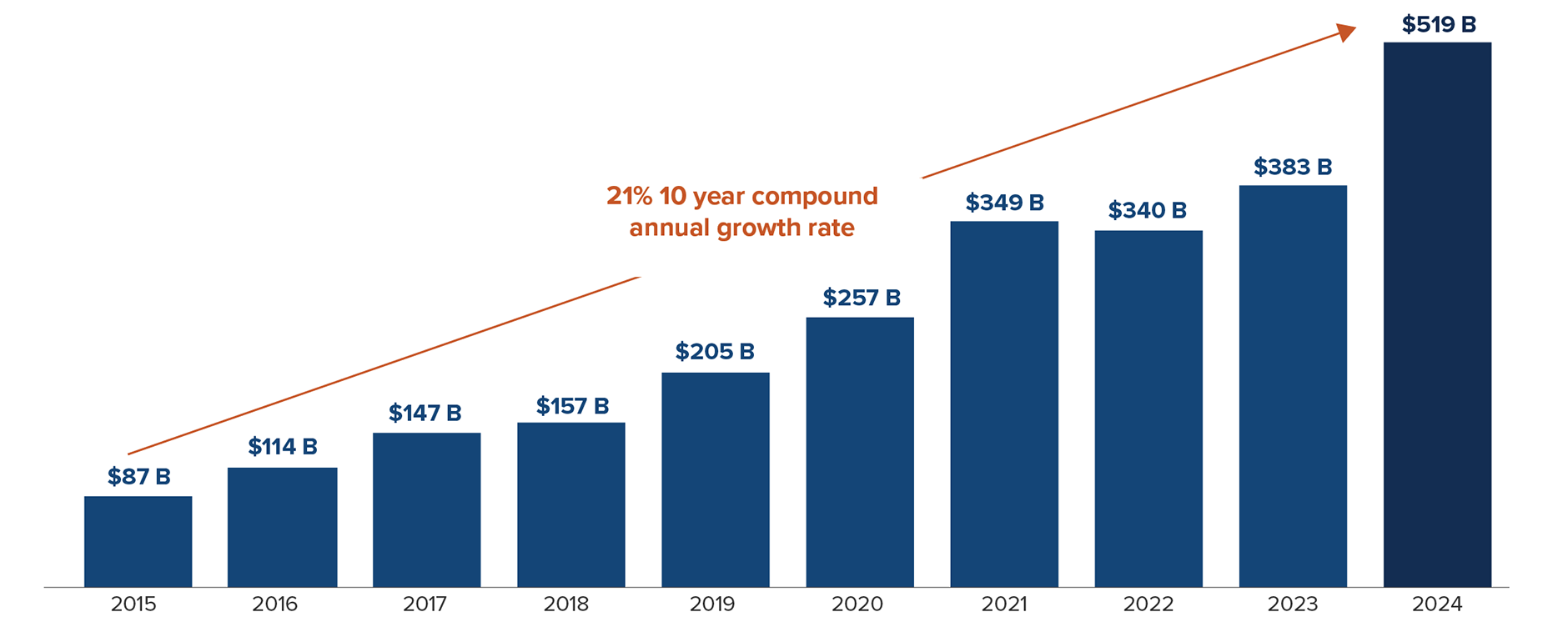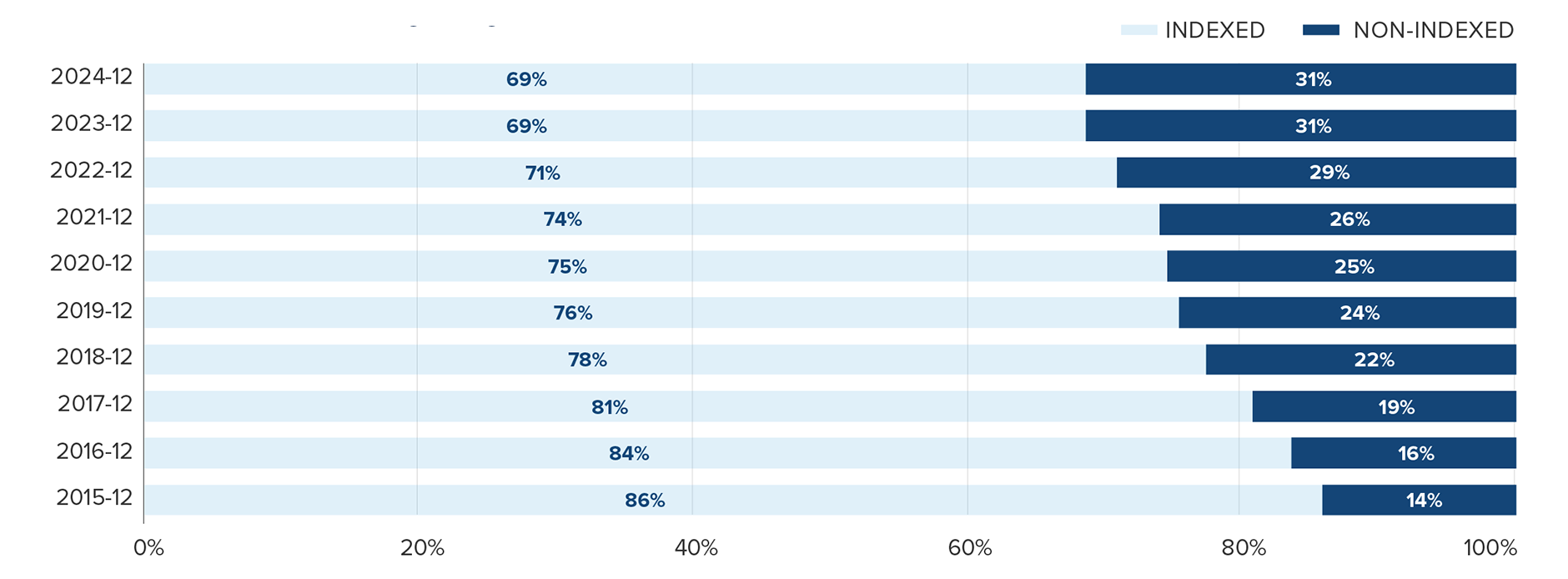As we look ahead to 2025, the ETF industry in Canada is expected to continue to grow. This is driven by evolving investor preferences and emerging macroeconomic conditions. The past year has set the stage for a more dynamic investment landscape, offering challenges and opportunities to investors and advisors alike. By the end of 2024, total assets under management reached $519 billion, driven by a record-breaking inflow of $76 billion beating the previous annual inflow record of $52.5 billion set in 2021.
The following chart illustrates that the Canadian ETF industry has enjoyed strong growth over the past 10 years growing at an annual compound growth rate of 21% on average. By year end, equity ETFs had inflows of $43.1 billion, fixed income ETFs had inflows of $24.0 billion and multi-asset ETFs gathered $9.0 billion.
Canadian ETFs AUM ($B)

Source: Morningstar. As at December 31, 2024. Canadian-listed ETF assets include holdings by retail investors as well as institutions and holdings by other investment funds.
Non-indexed ETFs growing market share
 Source: Morningstar. As at December 31, 2024.
Source: Morningstar. As at December 31, 2024.
Investor preferences and shifting trends
Investor behaviour in 2025 is likely to be influenced by macroeconomic factors such as interest rates, policies, inflation trends and geopolitical risk. Investors are expected to lean towards ETFs that offer:
- Inflation resilience: With central banks maintaining a cautious approach to rate adjustments, products that hedge against inflation will be highly sought after.
- Income generation: As real yields continue to adjust, there will be a strong preference for ETFs that provide sustainable income. Dividend-focused equity ETFs and fixed-income ETFs are particularly desirable as advisors can use these products to create steady income streams for clients.
- Thematic and sector rotation: Sector-specific ETFs focusing on energy, tech and industrials may see increased demand as investors look towards growth opportunities following economic disruptions in 2023 and 2024. Advisors should consider how sector ETFs can be used to capitalize on cyclical trends and support clients’ tactical allocations.
Key themes for 2025
- Navigating economic uncertainty: ETFs that provide exposure to defensive sectors or low-volatility strategies could play a crucial role in risk mitigation amid potential US policy shifts. Advisors can use these ETFs to help clients manage volatility and maintain risk during periods of uncertainty.
- Global diversification: Emerging market ETFs and global fixed-income ETFs provide exposure to growth regions while managing concentration risk. For advisors, these ETFs can help clients access new opportunities abroad and spread risk more effectively.
- Option-based ETFs to meet the strong demand for income: The adoption of option-based ETFs stems from investors’ income needs, tax efficiency and lower drawdowns during volatility.
- Active management: Active ETFs are gaining popularity amongst investors looking to outsource to portfolio managers the allocation in areas where they do not have adequate knowledge or expertise.
- Quality and valuation: With market valuations reaching mixed levels across sectors, ETFs that emphasize companies with strong balance sheets and consistent earnings growth will be attractive to investors looking for stability amid potential volatility. Advisors can use these ETFs to build a foundation of investments that support long-term wealth preservation.
Advisor considerations:
- Rapid growth of the ETF industry has provided advisors with an expansive toolkit that caters to all client needs. Understanding which ETF products align with current economic conditions can help advisors make informed decisions to enhance portfolio resilience and growth potential in clients’ portfolios.
- Core allocations can be built with broad-market ETFs, while satellite positions can employ sector ETFs to add targeted exposure.
- As market conditions evolve, being prepared to adjust exposure quickly is crucial. Advisors can use ETFs to shift between defensive and growth assets quickly and efficiently.
Outlook for growth:
Market projections indicate that AUM in ETFs could conservatively grow by 15%-20% as investors seek flexible, cost-effective solutions in response to fluctuations in economic conditions. Advisors will find opportunities to leverage ETFs as tools for strategic allocation, income generation and thematic expression. By aligning with key themes such as economic uncertainty, ESG integration and global diversification, advisors can better support their clients in achieving long-term investment goals. By embracing diverse ETF strategies, advisors can enhance portfolio resilience and capitalize on shifting market dynamics. A balanced approach across asset classes and geographies will be essential to navigating the complexities of the upcoming year.
Market projections indicate that AUM in ETFs could conservatively grow by 15%-20% as investors seek flexible, cost-effective solutions in response to fluctuations in economic conditions. Advisors will find opportunities to leverage ETFs as tools for strategic allocation, income generation and thematic expression. By aligning with key themes such as economic uncertainty, ESG integration and global diversification, advisors can better support their clients in achieving long-term investment goals. By embracing diverse ETF strategies, advisors can enhance portfolio resilience and capitalize on shifting market dynamics. A balanced approach across asset classes and geographies will be essential to navigating the complexities of the upcoming year.
Commissions, management fees, brokerage fees and expenses all may be associated with Exchange Traded Funds. Please read the prospectus before investing. Exchange Traded Funds are not guaranteed, their values change frequently and past performance may not be repeated.
This article may contain forward-looking information which reflect our or third-party current expectations or forecasts of future events. Forward-looking information is inherently subject to, among other things, risks, uncertainties and assumptions that could cause actual results to differ materially from those expressed herein. These risks, uncertainties and assumptions include, without limitation, general economic, political and market factors, interest and foreign exchange rates, the volatility of equity and capital markets, business competition, technological change, changes in government regulations, changes in tax laws, unexpected judicial or regulatory proceedings and catastrophic events. Please consider these and other factors carefully and not place undue reliance on forward-looking information. The forward-looking information contained herein is current only as of December 31, 2024. There should be no expectation that such information will in all circumstances be updated, supplemented or revised whether as a result of new information, changing circumstances, future events or otherwise.
The content of this article (including facts, views, opinions, recommendations, descriptions of or references to, products or securities) is not to be used or construed as investment advice, as an offer to sell or the solicitation of an offer to buy, or an endorsement, recommendation or sponsorship of any entity or security cited. Although we endeavour to ensure its accuracy and completeness, we assume no responsibility for any reliance upon it.
@2025 Morningstar. All Rights Reserved. The information contained herein: (1) is proprietary to Morningstar and/or its content providers; (2) may not be copied or distributed; and (3) is not warranted to be accurate, complete or timely. Neither Morningstar nor its content providers are responsible for any damages or losses arising from any use of this information. Past performance is no guarantee of future results.
